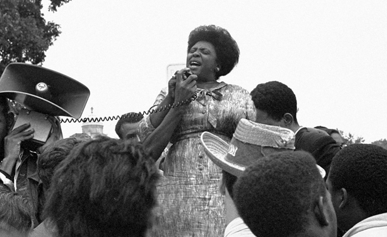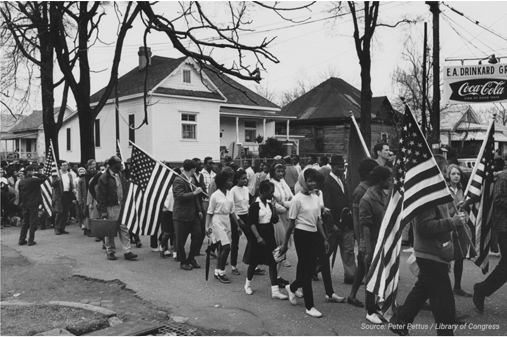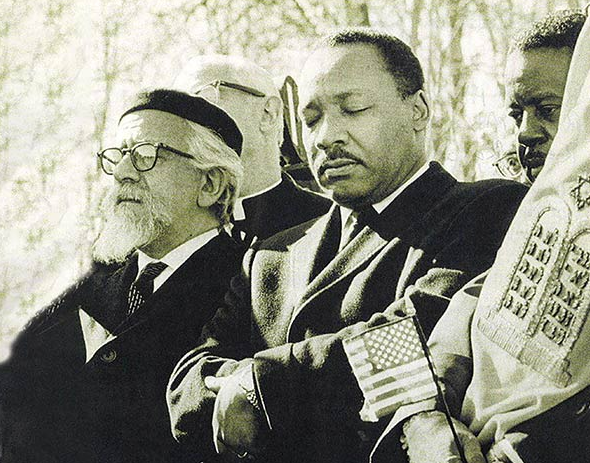The month of February is recognized as Black History Month, a time to recognize and celebrate the achievements and history of African Americans.
In the Humanity Gallery at the Nancy & David Wolf Holocaust & Humanity Center, we recognize modern day upstanders and those throughout history. Here are a few upstanders highlighted in our museum to celebrate this month.
Standing Up For Civil Rights
In 1965, African Americans still faced entrenched racism and discrimination in the United States and, in many places, were barred from voting. Individuals including Dr. Martin Luther King Jr. organized a march from Selma to Montgomery, Alabama to protest their lack of civil rights. On March 7, the police attacked the marchers as they tried to cross the Edmund Pettus Bridge. Known as “Bloody Sunday,” this event brought nationwide attention to the protests.
After Bloody Sunday, the size of the protest only increased. Dr. Martin Luther King Jr. sent telegrams calling on religious leaders from all over the nation to join. By March 17, the federal government agreed to protect the marchers with armed guards. Approximately 3,200 people left Selma, and by the time they reached Montgomery four days later, their numbers had grown to 25,000.
Fannie Lou Hamer
Fannie Lou Hamer, a sharecropper from Mississippi who was angered that African Americans were denied the right to vote, became an organizer of the Student Non-Violent Coordinating Committee.

In 1963, while attempting to register African Americans to vote, she was arrested, imprisoned, and severely beaten in jail. Guided by bravery and perseverance, she never wavered from fighting for civil rights. Hamer gave a stirring speech at the 1964 Democratic National Convention and worked that summer to organize youth to advocate for the right to vote. She was also alongside the marchers who made their way from Selma to Montgomery.
“Foot Soldiers”
Many of the Selma marchers—or “foot soldiers”—remain anonymous, but their presence was vital to the march’s success. Most came from different backgrounds but binding them together was the urgent need to effect change.

By showing up in Alabama, they faced great risk; 17 were hospitalized and over 50 others were beaten during the first march on Bloody Sunday. Their zest and teamwork helped draw national attention to the civil rights struggles happening in our country.
Rabbi Abraham Heschel
Rabbi Abraham Joshua Heschel arrived in Cincinnati as a 33-year-old refugee from Nazi Europe. He had lost his mother, two sisters, and most of his extended family to the Holocaust. This loss inspired a commitment to work for fairness and social justice.

Through his activism, he met and befriended Dr. Martin Luther King Jr., with whom he shared a deep spirituality and belief that social justice was rooted in their religious traditions. Days before the Selma march, King sent a telegram asking him to join. Heschel immediately packed his bags for Alabama.
Sparking Change
The events in Selma forced our lawmakers to respond with action. Within a few months, President Lyndon B. Johnson signed the Voting Rights Act into law, which empowered millions of African Americans to vote. To this day, however, Americans do not equally share civil rights. Advocacy and protest must continue.
During Black History Month, take the time to learn about and celebrate the upstanders who met their moment and took action to further civil rights, equality, and justice.
Find your moment to protect civil rights for all.
# # #
ABOUT THE NANCY & DAVID WOLF HOLOCAUST & HUMANITY CENTER
The Nancy & David Wolf Holocaust & Humanity Center exists to ensure the lessons of the Holocaust inspire action today. Located at Cincinnati’s historic Union Terminal, HHC impacts more than 2.5 million people every year through digital and in-person events, museum tours, educational experiences, social media, and virtual content. From Australia to India, individuals from more than 25 countries and 30 states engage with our mission. For more information, visit WWW.HOLOCAUSTANDHUMANITY.ORG.